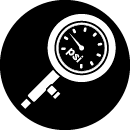Tire Safety Tips
Tire safety is extremely important to remember when taking care of your vehicle. Tires are one of the most important parts of a vehicle, they provide the grip that gets the vehicle down the road, support the entire weight of the vehicle, provide handling, and assist in braking. Tires are the only part of a vehicle that has direct contact with the road. To maximize the longevity and performance of a tire it is important to regularly monitor tire air pressure, tire wear, tire vehicle alignment, and tire rotation.

Tire air pressure should be checked at least once a month using a tire pressure gauge. Tires should be checked when they are cold (before being driven) or have been driven on less than one mile. Tires periodically lose air pressure even if they do not have leaks. Always refer to the vehicle’s door placard for specifications and proper tire air pressure.

It is important to regularly check all tires for irregular wear, tread depth, cracking, bulging, and damage.

Vehicle alignment is another step one can take to ensure you are getting the most out of your tires. Improper alignment can cause premature and uneven wear on tires. A proper alignment does not only help maximize the wear of tires, but it aids in the overall performance of the vehicle by ensuring it maintains a straight trajectory while driving forward. It can also improve fuel economy.

Tire rotation is one of the most important maintenance procedures you can do to help prolong the life of a tire. When a vehicle is driven down the road the tires gradually wear down, but they do not all wear at the same rate; front and rear tires wear differently. To extend the tread life of a tire it is recommended that tires should be rotated periodically. Tire rotation helps promote more even tire wear on all tires of the vehicle.
Consult your owner’s manual for recommendations on tire rotation frequency. If no information can be located, tire rotation every 5,000 to 8,000 miles is a good rule of thumb.


